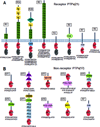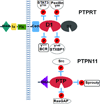Genetic alterations of protein tyrosine phosphatases in human cancers
- PMID: 25263441
- PMCID: PMC4377308
- DOI: 10.1038/onc.2014.326
Genetic alterations of protein tyrosine phosphatases in human cancers
Abstract
Protein tyrosine phosphatases (PTPs) are enzymes that remove phosphate from tyrosine residues in proteins. Recent whole-exome sequencing of human cancer genomes reveals that many PTPs are frequently mutated in a variety of cancers. Among these mutated PTPs, PTP receptor T (PTPRT) appears to be the most frequently mutated PTP in human cancers. Beside PTPN11, which functions as an oncogene in leukemia, genetic and functional studies indicate that most of mutant PTPs are tumor suppressor genes. Identification of the substrates and corresponding kinases of the mutant PTPs may provide novel therapeutic targets for cancers harboring these mutant PTPs.
Conflict of interest statement
The authors declare no conflict of interest.
Figures



Similar articles
-
Mutational analysis of the tyrosine phosphatome in colorectal cancers.Science. 2004 May 21;304(5674):1164-6. doi: 10.1126/science.1096096. Science. 2004. PMID: 15155950
-
Molecular Pathways: Targeting Protein Tyrosine Phosphatases in Cancer.Clin Cancer Res. 2017 May 1;23(9):2136-2142. doi: 10.1158/1078-0432.CCR-16-0934. Epub 2017 Jan 13. Clin Cancer Res. 2017. PMID: 28087641 Free PMC article. Review.
-
Protein tyrosine phosphatases, new targets for cancer therapy.Curr Cancer Drug Targets. 2006 Sep;6(6):519-32. doi: 10.2174/156800906778194603. Curr Cancer Drug Targets. 2006. PMID: 17017875 Review.
-
Use of Dominant-Negative/Substrate Trapping PTP Mutations to Search for PTP Interactors/Substrates.Methods Mol Biol. 2016;1447:243-65. doi: 10.1007/978-1-4939-3746-2_14. Methods Mol Biol. 2016. PMID: 27514810
-
Protein Tyrosine Phosphatases as Potential Regulators of STAT3 Signaling.Int J Mol Sci. 2018 Sep 11;19(9):2708. doi: 10.3390/ijms19092708. Int J Mol Sci. 2018. PMID: 30208623 Free PMC article. Review.
Cited by
-
The Structure, Function and Regulation of Protein Tyrosine Phosphatase Receptor Type J and Its Role in Diseases.Cells. 2022 Dec 20;12(1):8. doi: 10.3390/cells12010008. Cells. 2022. PMID: 36611803 Free PMC article. Review.
-
PTPN9 induces cell apoptosis by mitigating the activation of Stat3 and acts as a tumor suppressor in colorectal cancer.Cancer Manag Res. 2019 Feb 8;11:1309-1319. doi: 10.2147/CMAR.S187001. eCollection 2019. Cancer Manag Res. 2019. PMID: 30804683 Free PMC article.
-
Gene Expression of CRAL_TRIO Family Proteins modulated by Vitamin E Deficiency in Zebrafish (Danio Rerio).J Nutr Biochem. 2021 Nov;97:108801. doi: 10.1016/j.jnutbio.2021.108801. Epub 2021 Jun 10. J Nutr Biochem. 2021. PMID: 34119630 Free PMC article.
-
Defining the Protein-Protein Interaction Network of the Human Protein Tyrosine Phosphatase Family.Mol Cell Proteomics. 2016 Sep;15(9):3030-44. doi: 10.1074/mcp.M116.060277. Epub 2016 Jul 18. Mol Cell Proteomics. 2016. PMID: 27432908 Free PMC article.
-
Targeting Phosphatases and Kinases: How to Checkmate Cancer.Front Cell Dev Biol. 2021 Oct 28;9:690306. doi: 10.3389/fcell.2021.690306. eCollection 2021. Front Cell Dev Biol. 2021. PMID: 34778245 Free PMC article. Review.
References
-
- Julien SG, Dubé N, Hardy S, Tremblay ML. Inside the human cancer tyrosine phosphatome. Nat Rev Cancer. 2011;11:35–49. - PubMed
-
- Wang Z, Shen D, Parsons DW, Bardelli A, Sager J, Szabo S, et al. Mutational analysis of the tyrosine phosphatome in colorectal cancers. Science. 2004;304:1164–1166. - PubMed
-
- Alonso A, Sasin J, Bottini N, Friedberg I, Friedberg I, Osterman A, et al. Protein tyrosine phosphatases in the human genome. Cell. 2004;117:699–711. - PubMed
Publication types
MeSH terms
Substances
Grants and funding
LinkOut - more resources
Full Text Sources
Other Literature Sources
Miscellaneous

